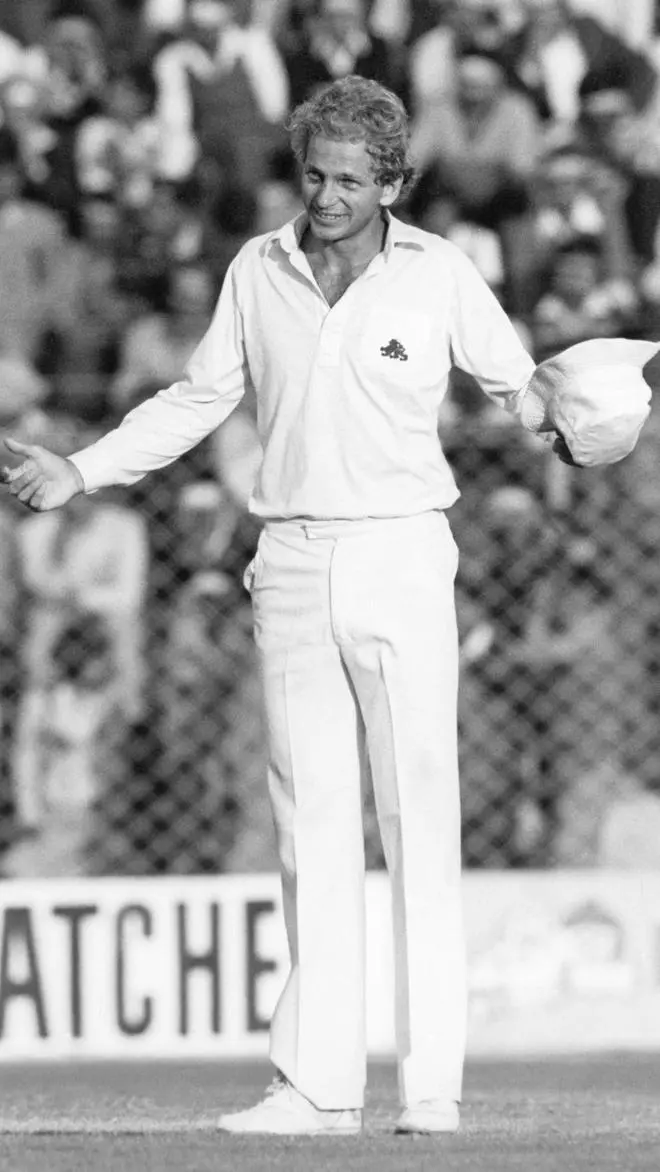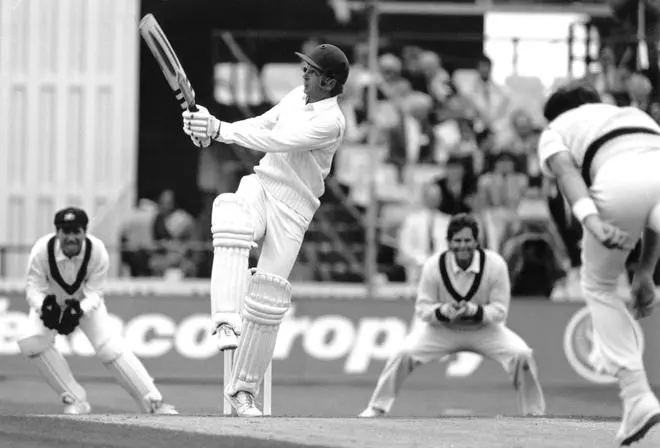The mops of angelic golden hair are gone – replaced by thinning silver strands, but the devastating charm is intact as David Gower, cricket’s most stylish southpaw takes the stage to talk about the game’s evolution into a big branded sport.
The charismatic cricketer who had equally successful innings as a television commentator draws a chuckle from the audience when he starts off by talking about the number of lovely people he met in India over the last couple of days who talked to him about cover drives, and cuts but had one question. “Where is the hair?”

David Gower’s in India during the 1984 tour when he led England to a memorable series win against the form book. PHOTO: THE HINDU ARCHIVES
“I apologise. Nature does things to all. The acres and acres of fluffy blond hair are gone. Take me as I am now, please,” he pleads.
The event is the International Advertising Association’s Global Summit on Nations as Brands and Gower lucidly talks about Brand Cricket and the shift of power from England, its home, to India.
The title of his talk ‘From Autograph to Photograph’ says it all. Just as today fans rarely whip out a pen to get signatures choosing a selfie with the star instead, the gentleman’s game has moved from the leisurely field to a television-driven billion-dollar spectator sport.
Gower acknowledged how India drives the game today.
“There is absolutely no denying that if you talk about cricket and if you talk about money, the first place you think about is India, where the entire business of cricket has changed the face of the game, the nature of it, and spread it around the world. The power lies here in India,” he said.

Considered the most elegant batsman of his era, Gower often had run-ins with the cricket establishment PHOTO: THE HINDU ARCHIVES | Photo Credit: ALLSPORT
And undeniably one platform has changed it all.
“The biggest brand in cricket around the world is spelt with three very big capital letters – IPL,” he said emphatically. “The single world I can use to describe IPL is ‘Phenomenal’. From a competition people were suspicious about, today it is revered around the world. The success of IPL is there to see,” he said.
Former Cricketer David Gower on the evolution of IPL and what it means for Cricket
The elegant Englishman noted, “In the early years IPL brought in big names like Shane Warne, Hayden, Gilchrist who gave it star quality. Now the situation is different. In order to be in IPL you have to be young, vibrant, and a big performer. It has brought many young Indian players to the foreground. “
Gower said the defining year for the shift in the game’s power was undoubtedly 1983 – the year India won the Prudential World Cup.
India’s 1983 world cup win
“On India’s magnificent win in 1983, I would like to hold up my hand and say that I feel largely responsible. You might ask why. Well, if you go back to the day in the summer of 1983 when England played India in the semi-finals, we were favourites to win the game. I was averaging 70 plus in the tournament but in that game, I was caught Kirmani, bowled Amarnath for 17, and from that point, India’s win in the semi-finals was guaranteed,” points Gower.
“1983 was the genesis of the belief in the entire nation of India on the one day game,” he said.
The advent of money
Gower said that the timing of his career was “nigh on perfect” as the ability of cricket players to earn money was starting at that time. Kerry Packer had just happened around the time Gower made his debut at age 21.
“If you were an England cricketer in 1977, you played a five-day game for 200 pounds, in other words English players took on the likes of Dennis Lillee and Jeff Thomson almost for free. You played for honour, you played for the challenge, you played for all kinds of amateurish reasons. In 1978, the year I made my debut, the fee had gone up by five times to 1,000 pounds,” he recalled.
This was thanks to Cornhill Insurance sponsoring the English cricket team. “My first test match concluded with the start of sponsorship. This was the first experience we had of branding of the centuries-old game,” he pointed out.
As an aside, he remarks how from insurance companies sponsoring the English team, now they have an online used car marketplace, Cinch, as a sponsor.
In those early days, Gower pointed out how the tour fees barely covered the cost of a bottle of French wine in a country like India.
Former Indian cricketer Dilip Vengsarkar, who joined him on stage for a panel discussion on the evolution of the game, also had amusing stories to share about small cheques and huge fines in the days when big money was yet to make inroads into cricket.
In 1989, after the tour of the West Indies, Vengsarkar played a couple of exhibition matches in the US and was fined by BCCI to the tune of ₹50,000. “I was actually contemplating a loan to pay the fine,” disclosed Vengsarkar.
On the future of cricket , Gower bats for balance. While the shorter formats have brought in spectators, sponsors, and money, the five-day game needs to be kept alive.
“Just as we blend the paper, the pen, and the mobile phone, we need to keep all formats of the game intact,” he concluded.




Comments
Comments have to be in English, and in full sentences. They cannot be abusive or personal. Please abide by our community guidelines for posting your comments.
We have migrated to a new commenting platform. If you are already a registered user of TheHindu Businessline and logged in, you may continue to engage with our articles. If you do not have an account please register and login to post comments. Users can access their older comments by logging into their accounts on Vuukle.